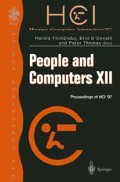Abstract
Formal modelling of situated actions and context is a worthwhile endeavor if it provides a framework for verifying requirements correctness and generates principles for building interfaces for fluid interactions. The paper argues that action sequences, rather than states, are a suitable representation for this problem, and proposes a situated action calculus based on a new material implication relation among contexts. The situated action calculus extends in two respects a story-telling theory for embedding the user requirements in meaningful contexts. First, it provides a formalism and a set of operators that allow the designer to verify that stories told by different actors generate a safe and live representation; and second, it allows partitioning such representation in a succession of scenes which can be aggregated to define for each actor an interface that unfolds with the task and the context.
Access this chapter
Tax calculation will be finalised at checkout
Purchases are for personal use only
Preview
Unable to display preview. Download preview PDF.
References
Carchiolo, V., Di Stefano A., Faro, A. and Pappalardo G. (1989). ECCS and LIPS two languages for OSI systems specification and verification. ACM Transactions On Programming Languages and Systems, 11 (2), 284–329.
Carroll, J. M. (Ed.), (1995) Scenario-based Design: Envisioning work and technology in system development. John Wiley, New York.
Faconti, G. P., Fornari, A. and Zani, N. (1994). Visual representation of formal specification: an application to hierarchical logical input devices. In F. Paterno’ (Ed.), Interactive Systems Design and Specification, l s ` Eurographics Workshop, Bocca di Magra, Italy, June 1994. Springer-Verlag.
Faro, A. and Giordano, D. (1995). From information systems specification to user’s mental models and viceversa by extended visual notation. In Proc. IPCC’95, IEEE International Professional Communication Conference,Savannah, Georgia.
Faro, A. and Giordano, D. (1996). Story telling reasoning to learn Information Systems design. In Proc. Euro AIED96, European Conference on Artificial Intelligence in Education,Lisbon, Portugal.
Faro, A. and Giordano, D. (1997). Between narration and drama: information systems modelling revisited. In Proc. ECIS 97 European Conference on Information Systems,Cork, Ireland.
Goffman, E. (1974). Frame Analysis. Harvard University Press, Cambridge. Hayes P.J. (1971). A logic of actions, Machine Intelligence, 6, 495–520.
Harrè, R., Clarke D. and De Carlo N. (1985) Motives and Mechanisms: an introduction to the psychology of action. Methuen, London
Johnson, H. and Johnson, P. (1991). Task Knowledge Structures: Psychological basis and integration into system design, Acta Psychologica, 78, 3–26.
Jordan, B. and Henderson, A. (1995). Interaction analysis: foundations and practice. The journal of the learning sciences, 4 (1), 39–103.
Kyng, M. (1995). Making representations work. Communications of the ACM, 38 (9), 46–55.
McCarthy J. and Hayes P.J. (1969). Some philosophical problems from the standpoint of artificial intelligence, Machine Intelligence, 4, 463–502.
Mizogushi, R.,Tijerino Y., and Ikeda M. (1995). Task analysis interview based on task ontology. Journal of Expert Systems with Applications, 9 (1), 15–25.
Monk, A. F. and Curry, M. B. (1994). Discount dialogue modelling with Action Simulator. In Cockton, G., Draper, S. W. And Weir, G. R. S. (Eds.), People and Computers 9- Proceedings HCI’94, Cambridge University Press.
Potts, C. (1995). Using schematic scenarios to understand user needs. ACM Proc. DIS’95- Designing Interactive systems. Ann Arbor, Michigan.
Suchman, L.A. (1987). Plans and-situated actions: The problem of human-machine communication. Cambridge University Press. New York.
Suchman, L.A. (1993) Response to Vera and Simon’s situated action: a symbolic interpretation. Cognitive Science, 17, 71–75.
Turner, J. H. (1988). A theory of social interaction. Stanford University Press, Stanford.
Author information
Authors and Affiliations
Editor information
Editors and Affiliations
Rights and permissions
Copyright information
© 1997 Springer-Verlag London
About this paper
Cite this paper
Faro, A., Giordano, D. (1997). Towards a situated action calculus for modelling interactions. In: Thimbleby, H., O’Conaill, B., Thomas, P.J. (eds) People and Computers XII. Springer, London. https://doi.org/10.1007/978-1-4471-3601-9_7
Download citation
DOI: https://doi.org/10.1007/978-1-4471-3601-9_7
Publisher Name: Springer, London
Print ISBN: 978-3-540-76172-3
Online ISBN: 978-1-4471-3601-9
eBook Packages: Springer Book Archive

